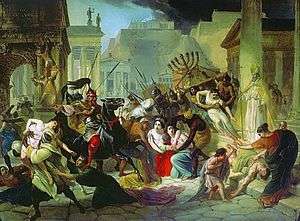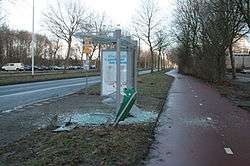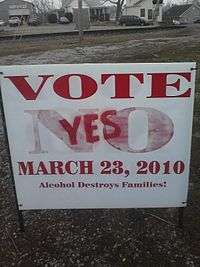Vandalism

Vandalism is "action involving deliberate destruction of or damage to public or private property".[1]
The term includes criminal damage such as graffiti and defacement directed towards any property without permission of the owner. The term finds its roots in an Enlightenment view that the Germanic Vandals were a uniquely destructive people.
Origin of the term

The Vandals, an ancient Germanic people, are associated with senseless destruction as a result of their sack of Rome under King Genseric in 455. During the Enlightenment, Rome was idealized, while the Goths and Vandals were blamed for its destruction. The Vandals may not have been any more destructive than other invaders of ancient times, but they did inspire British poet John Dryden to write, Till Goths, and Vandals, a rude Northern race, Did all the matchless Monuments deface (1694). However, the Vandals did intentionally damage statues, which may be why their name is associated with the vandalism of art. The term Vandalisme was coined in 1794 by Henri Grégoire, bishop of Blois, to describe the destruction of artwork following the French Revolution. The term was quickly adopted across Europe. This new use of the term was important in colouring the perception of the Vandals from later Late Antiquity, popularising the pre-existing idea that they were a barbaric group with a taste for destruction.[2]
Historically, vandalism has been justified by painter Gustave Courbet as destruction of monuments symbolizing "war and conquest". Therefore, it is often done as an expression of contempt, creativity, or both. Gustave Courbet's attempt, during the 1871 Paris Commune, to dismantle the Vendôme column, a symbol of the past Napoleon III authoritarian Empire, was one of the most celebrated events of vandalism. Nietzsche himself would meditate after the Commune on the "fight against culture", taking as example the intentional burning of the Tuileries Palace on May 23, 1871. "The criminal fight against culture is only the reverse side of a criminal culture" wrote Klossowski after quoting Nietzsche.[3]
In a proposal to the International Conference for Unification of Criminal Law held in Madrid in 1933, Raphael Lemkin envisaged the creation of two new international crimes (delicta juris gentium): the crime of barbarity, consisting in the extermination of racial, religious or social collectivities, and the crime of vandalism, consisting in the destruction of cultural and artistic works of these groups.[4] The proposal was not accepted.
As a crime


Private citizens commit vandalism when they willfully damage or deface the property of others or the commons. Some vandalism may qualify as culture jamming or sniggling: it is thought by some to be artistic in nature even though carried out illegally or without the property owner's permission. Examples include at least some graffiti art, billboard "liberation" and possibly crop circles. Criminal vandalism takes many forms. Graffiti on public property is common in many inner cities as part of a gang culture, where they might be used as territorial markers.[5] More serious forms of vandalism that may take place during public unrest such as rioting can involve the willful destruction of public and private property. Vandalism per se is sometimes considered one of the less serious common crimes, but it can become quite serious and distressing when committed extensively, violently or as an expression of hatred and intimidation. In response, local governments have adopted various legal measures to prevent vandalism, but research has shown that the conventional strategies employed by the government in response to at least unapproved graffiti are not the most effective.[6]
Examples
Examples of vandalism include salting lawns, cutting trees without permission, egg throwing, breaking windows, arson, spraying paint on others' properties, tagging, placing glue into locks, tire slashing, keying (scratching) paint, throwing shoes on power lines or similar esctructures, ransacking a property, and flooding a house by clogging a sink and leaving the water running.
Political


In elections, opposing candidates' supporters may engage in "political vandalism" - the act of defacing opponents' political posters, bumper stickers, billboards, and other street marketing material. Although the nature of this material is temporary, its effect can be long-lasting as it may reflect both negatively and positively on the candidate whose material is being vandalized as well as on the presumed candidate whose supporters are engaging in the vandalism.
Also activists may use the tactic of property destruction[7] as means of protest, e.g. by smashing the windows of banks, shops and government institutions and setting fire to cars. This often takes place during riots but can also happen as a stand-alone event, e.g. by animal rights activists destroying property owned by farmers, biotech companies and research facilities and setting free animals (which is sometimes referred to as eco-terrorism by opponents). Vandalism is also a common tactic of black blocs.
Motives
Actions of this kind can be ascribed to anger or envy, or to spontaneous, opportunistic behaviour– possibly for peer acceptance or bravado in gang cultures, or disgruntlement with the target (victim) person or society. Opportunistic vandalism of this nature may also be filmed, the mentality of which can be akin to happy slapping. The large-scale prevalence of gang graffiti in some inner cities has almost made it acceptable to the societies based there– so much so that it may go unnoticed, or not be removed, possibly because it may be a fruitless endeavour, to be graffitied on once again. Greed can motivate vandalism as can some political ideologies, wish to draw attention to problems, frustration, even playfulness. Youngsters, the most common vandals, frequently experience low status and boredom. Vandalism enables powerless people to attack those above them, take control and frighten others. Unpunished vandalism can provide relief which reinforces the behaviour. Vandalism by one person can lead to imitation.[8] Teenage boys and men in their 20s are most likely to vandalize, but older adults and females are also known to sometimes vandalize, with young children occasionally vandalizing, but in a much smaller form, such as making small crayon drawings on walls.
Criminological research into vandalism has found that it serves many purposes for those who engage in it and stems from a variety of motives. Sociologist Stanley Cohen describes six different types of vandalism:[9]
- Acquisitive vandalism (looting and petty theft).
- Peer pressure - Teenagers spend more time away from home with peers whether they act constructively or destructively can depend on the contacts they make. Disobeying authority can appear cool.
- Tactical vandalism (to advance some end other than acquiring money or property – such as breaking a window to be arrested and get a bed for the night in a police cell).
- Ideological vandalism (carried out to further an explicit ideological cause or deliver a message).
- Vindictive vandalism (for revenge).
- Play vandalism (damage resulting from children’s games).
- Malicious vandalism (damage caused by a violent outpouring of diffuse frustration and rage that often occurs in public settings).[10] Cohen's original typology was improved upon by Mike Sutton [11] whose research led him to add a seventh sub-type of vandalism – Peer Status Motivated Vandalism.[12] This seventh category was found by criminologist Dr. Mathew Williams to be the best fit for explaining the virtual vandalism he studied. Williams’ seminal paper in the Internet journal of criminology[13] makes a significant contribution to understanding the motivations for vandalism, and the characteristics of the dynamics of the groups that participate in it.
Reaction of authorities

In view of its incivility, punishment for vandalism can be particularly severe in some countries. In Singapore, for example, a person who attempts to cause or commits an act of vandalism may be liable to imprisonment for up to 3 years and may also be punished with caning. Vandalism in the UK is construed as an environmental crime and may be punished with an ASBO (Anti-Social Behaviour Order).
Former New York City mayor Rudolph Giuliani made a crackdown on vandalism a centerpiece of his anti-crime agenda in the 1990s, asserting that a strong campaign against nonviolent "quality of life" crimes such as vandalism would bring about a corresponding decrease in violent crime. According to FBI statistics, New York's crime rate plummeted during his tenure.[14]
Cybervandalism
Cybervandalism is vandalism on the internet. For example, vandalism on Wikipedia involves adding questionable content, removing content, or changing content in order to make it questionable, generally with the objective of harming Wikipedia's reputation. Forms of online vandalism have been recorded, the most common of which is website defacement. Vandalism on web maps has been called "cartographic vandalism".[15] Another form of cybervandalism is creation of malware, such as viruses, Trojan horses, and spyware, which can destroy computers, and in some cases even steal money from the computer owners, wherein the malware creator blackmails the owner to pay them money or give out their credit card number or else they won't get the use of their computer back. Some even go as far as making a time limit where if the owner doesn't pay or give personal information within a certain time, the malware permanently destroys the computer.
As art


Though vandalism in itself is illegal, it is often also an integral part of modern popular culture. French painter Gustave Courbet's attempt to disassemble the Vendôme column during the 1871 Paris Commune was probably one of the first artistic vandalist acts, celebrated at least since Dada performances during World War I. The Vendôme column was considered a symbol of the recently deposed Second Empire of Napoleon III, and dismantled as such.
After the burning of the Tuileries Palace on May 23, 1871, Philosopher Friedrich Nietzsche himself meditated about the "fight against culture", wondering what could justify culture if it were to be destroyed in such a "senseless" manner (the arguments are: culture is justified by works of art and scientific achievements; exploitation is necessary to those achievements, leading to the creation of exploited people who then fight against culture. In this case, culture cannot be legitimised by art achievements, and Nietzsche writes: "I {also} know what it means: fighting against culture". After quoting him, Klossowski writes: "The criminal fight against culture is only the reverse side of a criminal culture".[3]
As destruction of monument, vandalism can only have sense in a culture respecting history, archeology - Nietzsche spoke of monumental history. As destruction of monumental history, vandalism was assured a long life (as Herostratus proved): Performance art could make such a claim, as well as Hakim Bey's poetic terrorism or Destroy 2000 Years of Culture from Atari Teenage Riot. Gustave Courbet's declaration stated:
"Attendu que la colonne Vendôme est un monument dénué de toute valeur artistique, tendant à perpétuer par son expression les idées de guerre et de conquête qui étaient dans la dynastie impériale, mais que réprouve le sentiment d’une nation républicaine, [le citoyen Courbet] émet le vœu que le gouvernement de la Défense nationale veuille bien l’autoriser à déboulonner cette colonne."[16]
("As the Vendôme column is a monument devoid of any artistic value, whose expression tends to perpetuate the ideas of war and conquest from the imperial dynasty, but that reject the sentiment of a republican nation, citizen Courbet declares that the government of National Defense should allow him to dismantle this column.")
Hence, painter Courbet justified the dismantlement of the Vendôme column on political grounds, downgrading its artistic value. Vandalism poses the problem of the value of art compared to life's hardships: Courbet thought that the political values transmitted by this work of art neutralized its artistic value. His project was not followed; however, on April 12, 1871, the Commune voted to dismantle the imperial symbol, and the column was taken down on May 8. After the assault on the Paris Commune by Adolphe Thiers, Gustave Courbet was condemned to pay part of the expenses.
In 1974, Norman Mailer glorified the art of vandalism in his essay "The Faith of Graffiti," which likened tagging in New York City to the work of Giotto and Rauschenberg. New York Authorities responded by coating subway walls with Teflon paint, jailing taggers and requiring hardware stores to keep spray paint under lock and key.[17]
Tags, designs, and styles of writing are commonplace on clothing and are an influence on many of the corporate logos. Many skateparks and similar youth-oriented venues are decorated with commissioned graffiti-style artwork, and in many others patrons are welcome to leave their own. There is still, however, a fine line between vandalism as an artform, as a political statement, and as a crime. Bristol-born guerrilla artist Banksy is an example: when councils have removed his works, they have been met by public outrage. Banksy's claim is that official vandalism is far worse than that perpetrated by individuals, and that he is decorating buildings of no architectural merit whatsoever.
Notes
- ↑ "Oxford English Dictionary". Oxford University Press. Retrieved 2015-04-25.
- ↑ Merrills and Miles 2010, pp. 9–10.
- 1 2 See Pierre Klossowski, Nietzsche and the Vicious Circle, first Chapter: What is the value of culture if those who are exploited by it destroy it? "En sorte qu'il nous faut être bien loin de vouloir, du haut de notre sentiment de nous-mêmes, imputer le crime d'un combat contre la culture exclusivement à ces malheureux. Je sais ce que cela veut dire: le combat contre la culture. (...) je me campronnai avec une conviction sérieuse à la valeur métaphysique de l'art, lequel ne saurait exister à cause des pauvres gens, mais doit accomplir des missions plus hautes. Mais, en dépit de mon extrême douleur, je n'étais pas en état de jeter la moindre pierre à ces profanateurs qui, pour moi, n'étaient que les suppôts de la culpabilité universelle, sur laquelle il y a beaucoup à méditer!" Nietzsche quoted by Klossowski pp.29-30 French edition, who adds: "Le combat criminel contre la culture n'est lui-même que l'envers d'une culture criminelle" ("The criminal fight against culture is only the reverse side of a criminal culture")
- ↑ Raphael Lemkin: Akte der Barbarei und des Vandalismus als delicta juris gentium, Anwaltsblatt Internationales (Wien), November 1933.
- ↑ Ley and Cybriwsky 1974.
- ↑ J. Scott Armstrong (1978). "The Graffiti Solution" (PDF). The Wharton Magazine.
- ↑ Is it OK for protesters to damage property?, New Internationalist Magazine, issue 440
- ↑ Psychological Analysis of Vandalism
- ↑ Cohen 1973.
- ↑ The Psychological View of Why Children Vandalize
- ↑ "Center for Problem-Oriented Policing | Biographies". Popcenter.org. Retrieved 2012-12-10.
- ↑ Sutton, Mike (1987) Differential Rates of Vandalism in a New Town: Towards A Theory of Relative Place. Unpublished PhD Thesis, University of Central Lancashire, October
- ↑ Understanding King Punisher and His Order: Vandalism in an Online Community - Motives, Meanings and Possible Solutions http://www.internetjournalofcriminology.com/Williams%20-%20Understanding%20King%20Punisher%20and%20his%20Order.pdf
- ↑ "FBI Crime Statistics For Calendar Year 2000 Show Drop In New York City Crime" (Press release). NYC Mayor's Press Office. 2001-05-30. Retrieved 2007-08-04.
- ↑ Ballatore 2014.
- ↑ "La Colonne Vendôme déboulonnée" (in French). Retrieved 2007-08-04.
- ↑ Fine Art, Sí, Vandalism, No
References
- Ballatore, A. (2014), "Defacing the map: Cartographic vandalism in the digital commons", The Cartographic Journal, 51 (3): 214–224, arXiv:1404.3341
 , doi:10.1179/1743277414y.0000000085
, doi:10.1179/1743277414y.0000000085 - Cohen, S. (1973), Ward, C., ed., Property destruction: Motives and meanings, London: Architectural Press, pp. 23–53
- Goldstein, A. (1996), The Psychology of Vandalism, New York: Plenum Press
- Ley, D. & Cybriwsky, R. (1974), "Urban Graffiti as Territorial Markers", Annals of the Association of American Geographers, 64 (4): 491–505, doi:10.1111/j.1467-8306.1974.tb00998.x
- Merrills, A.; Miles, R. (2010), The Vandals, John Wiley & Sons, ISBN 978-1-4051-6068-1
- Williams, M. (2006), Virtually Criminal: Crime, Deviance, and Regulation Online., Abington, UK: Taylor & Francis
External links
- The Free Dictionary: Vandalism
- Merriam Webster: Vandalism
 The dictionary definition of vandalism at Wiktionary
The dictionary definition of vandalism at Wiktionary Media related to Vandalism at Wikimedia Commons
Media related to Vandalism at Wikimedia Commons
